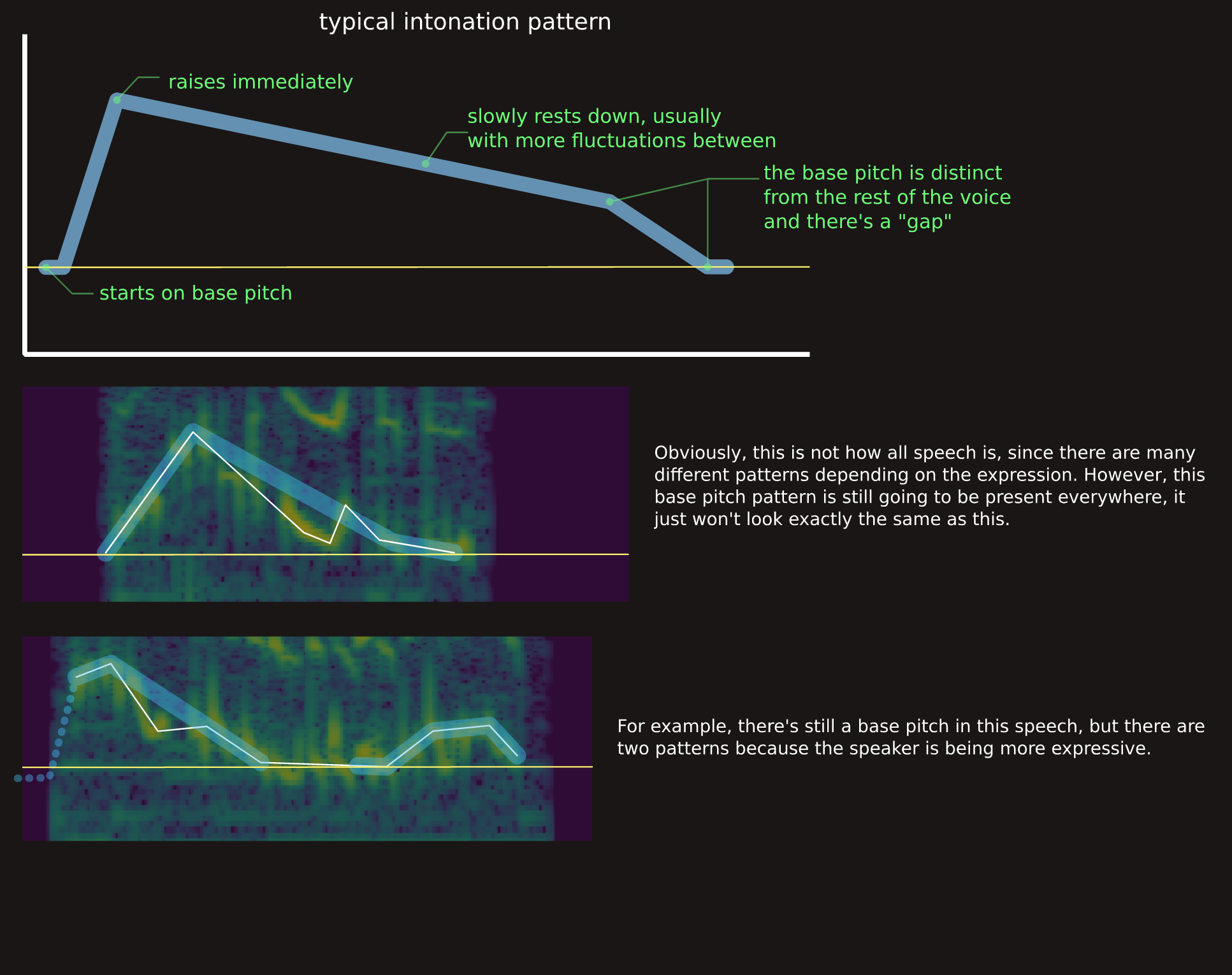This site is under construction! Stuff be missing, beware! Contribute!
If you have additions, corrections or concerns, open an issue or contact a maintainer.
Voice Map is released! See here for a giant map of (almost) all voice characteristics and pedagogy!Table of contents
Base Pitch
When normally speaking, the voice will raise for intonation and then eventually come back down to rest on the same pitch over and over. This pitch the voice naturally wants to return to is called the Base Pitch, and is determined mostly by vocal weight.
Heavier vocal weight –> lower base pitch Lighter weight –> can maintain higher base pitch
In other words, base pitch is the pitch the voice naturally returns to after intonation (inflection). If you draw out the last word in the following phrases, that will tell you your current base pitch, provided you do it “naturally” without forcing the voice to stay high.
Open the crate but don’t break the glass.
Oak is strong and also gives shade.

Pitch Matching and Control
If you find it hard to keep a base pitch, it might be that you don’t have much awareness or control over pitch. Pitch matching is a good way to fix this, so be sure to use that if you get stuck. Not everyone starts with an ability to match and control pitch, but almost everyone can learn it, usually quite rapidly too.
Exercises
As in Pitch Naturalisation, we can use base pitch to change parts of the voice, notably vocal weight. Below are some methods to change the base pitch.
Intuitive base pitch
This is the main method for changing the base pitch. Importantly, it isn’t tightly controlled or forced; we need the voice to naturally want to stay here, and forcing it to do so will not achieve that.
- base pitch is the pitch that you always come back down to after inflection / intonation; it’s almost always the lowest note in speech
- play the note or hum the note of where you want to speak
- use a phrase that starts at the base pitch like “the north wind and the sun had a quarrel”
- the voice will immediately go up for intonation and that’s a good thing
- when you intonate up and it starts coming down again, make sure it hits the base pitch
- the more “hesitant” it is to fall down, the less likely it is to drop below the intended base pitch, so it’s good to bias the voice higher in pitch for the intonation
- gradually start to just speak naturally instead of control the pitch, but whenever your voice hits that base pitch, just notice that and draw attention to it
- likewise pay attention to if your voice drops below the base pitch
- you can also draw out the base pitch note longer if you need to (e.g. on “quarrel”), but prioritise just noticing it passively
- eventually you’ll memorise and keep the base pitch subconsciously without needing to drill for it
Singing base pitch (contrived)
This more or less “forces” a base pitch if you have trouble with the more intuitive methods. Keep in mind if the pitch is too high it will be straining and achieve nothing, so only use this for getting used to controlling the base pitch at all, not for doing a higher and higher pitch.
- pick a pitch, and some other pitch that is a bit higher
- say “one” at the high one, and “two” at the low one, as if singing those notes
- say some phrase like
?crateor?northwind, where it starts at the high note, and only at the very end comes down to the low note - e.g. “[high] open the crate but don’t break the [low] glass”
- this is very contrived of course but it can be made more natural by doing less of the “singing” quality
<!- –>